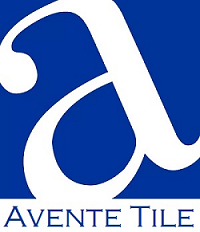A Step-by-Step Guide to Customizing Cement Tiles Patterns
Get creative with cement tiles and choose the colors you want for any pattern. Yes, you can pick the colors that you want to use on any cement tile pattern. Remember sitting down with a box of crayons and a coloring book as a kid? It's sort of the same thing. Tell us what pattern you like and we'll provide a box of crayons (colors) that you use to create your own unique design. Whether a DIYer or an experienced designer or architect, our step-by-step guide will help you understand the process and decisions involved in the creative process of customizing colors for any encaustic cement tile pattern we have!
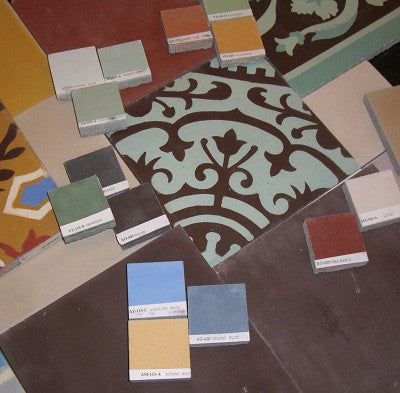
Cement Tile with Color Chips
Just so we are clear, you don't get to color the actual tile yourself - we do that for you in a factory with skilled tile artisans. However, you do get to choose the colors and decide where to place them on the pattern. It's your design and you end up with a tile to match your exact style and taste and color. Creative people, like designers and architects, will find the perfect custom solution when using cement tiles - especially when you need to match floor tiles or a back splash to specific colors for a design.
Here's a look at some some different ways you can customize the colors on a pattern. These renderings were all created for our customers to help them decide which colors and pattern were right for their home. We'll use this same Cuban pattern in our step-by-step guide. You might be surprised at how different the colors make a pattern look and feel.
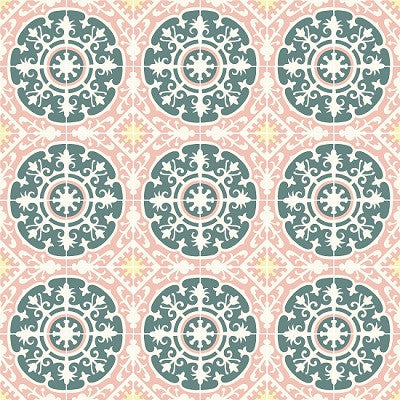
Cuban Heritage Pattern 140 in a Custom Colorway

Cuban Heritage Pattern 140 in a Custom Colorway
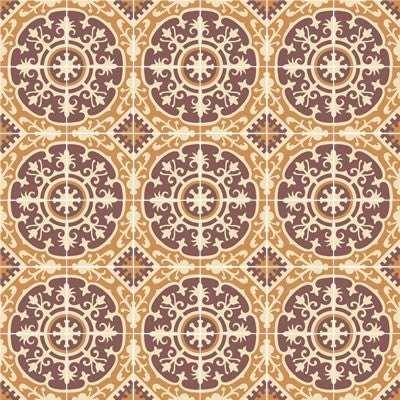
Cuban Heritage Pattern 140 in a Custom Colorway
As with any custom project, you must allow additional time to choose the colors, apply them to the pattern, and for samples to be created. Be prepared, your first design may not be exactly what you imagined. Allow time for several "designs" to be created so you are sure to find the one you really love. Remember, colors play off of each other and how a pattern repeats may look very different with one set of colors than another.
In this step-by-step guide, we're going to point you in the right direction with a few tips to follow. We'll use a real-life example to show you how we applied these tips so you can see how this process works.
-
Pick a pattern that you really love. Remember the pattern can change by using different colors or if you choose the same colors next to adjacent section of the pattern. We really like Cuban Heritage Design 140-1A. It's a great 8" x 8" floor tile; but the Indian Red and Goldenrod colors aren't right for our home. We also want to make the design more contemporary and will drop the border and run the pattern to the edge of the room.

Cuban Heritage Pattern 140-1A Rug Design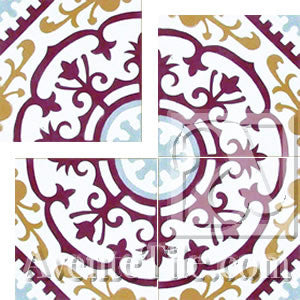
Cuban Heritage Pattern 140-1A Field PatternWhen choosing patterns, just about any pattern can work in any space; but, you have to consider scale. A really large pattern and border that requires four 8-inch tiles just won't work behind an 18" backsplash. Once you have a sense for the pattern you like, it's a good idea to layout the design in the space. If you aren't handy with scaled design, let us know. Our design services team can help.
DESIGN TIP: Consider scale when picking a pattern. Answer the question, "Does this pattern fit in the space?" Large patterns don't work well in small or very irregular places.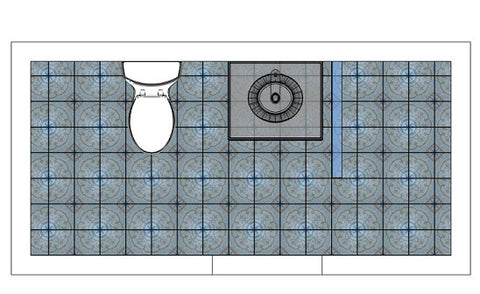
Layout and scale are key to determining if a pattern works in a spaceIt's really difficult to create a rug design in the bathroom above with the CH140 pattern. Since you don't want to run the border to the edge of the room - to avoid cuts - and the house is old construction where nothing is plumb and square, the customer opted to run the pattern to the edge of the room and into the show as well.
DESIGN TIP: Consider the style of your home or space when choosing a pattern. Geometric patterns often work well for contemporary spaces. Stylistic patterns work well in more traditional and formal spaces.It's also helpful to consider your home's architecture and the room's purpose when choosing a pattern. Cuban patterns and traditional patterns work well in Spanish and Spanish Revival homes because the architectural details support the stylistic pattern details. Geometric patterns, with their clean lines, work well in Ranch-style homes or mid-Century modern styles. A formal dining room looks great with a cement tile rug where a contemporary bath would look great a simple, geometric pattern run to the edge of the room. Finally, remember, these are guidelines to help and not hard rules to slavishly follow.
-
Decide on the color scheme for the cement tile. The tile's color scheme might compliment a room's existing colors or stand-alone as the focal point of the space. Decide on the color scheme before you do anything else. For instance, I love green. It can be very soothing and works nicely with neutral colors and wood tones that are easy-on-the-eye. My color scheme is "green." Remember, you need to work with each manufacturer's available color palette. Because we are using a Cuban Heritage tile pattern, we need to choose colors from the Heritage Color Palette line that will work for our color scheme.
DESIGN TIP: Color choices are more important than pattern for any design.
While finding a pattern you like is important, color choices trump pattern every time. You can use almost any pattern if the colors are right.
-
Chose the specific colors you want to use. There are over 80 colors in the Heritage cement tile color pallete, so it wasn't hard to find a few that we really liked. After looking at all the colors, I decided on a few: Antique Ivory, Amber White, Romaine, Melon Green, and Blanched Turf.
-
Order color chips of the colors you are considering. We have an exhaustive collection of colors, so we purchased a Heritage Color Chip Set. It is very important to see both the finish and texture in addition to the color that you are considering. Place the samples together in the location and same position where they will be used. Find a color combination that suits you. Make sure to look at them during different times of day and consider how color changes when natural light is available. Place the color chips and tiles next to samples of other finished surfaces that you are considering and consider the pattern on the tiles.
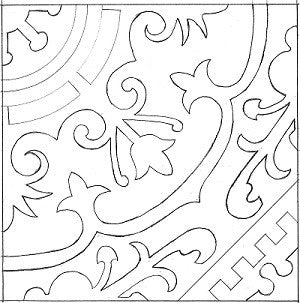
Cuban Heritage Pattern 140 Line ArtWhat dominate colors do you like? Those colors will define the pattern. What neutral or complimentary colors do you like? They should be used for the background. After a week, you'll know what is working and what is not.
-
Decide where to place each color on the pattern. Using your colors, decide where you want to place each color on the pattern. Try two or three different arrangements. Generally, you want one primary or accent color that defines the pattern with a complimentary color on a neutral background.
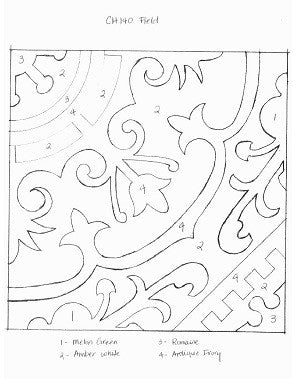
New Colors on Pattern Cuban Heritage Pattern 140We came up with two different substitutions:
Substitution #1: Melon Green for Golden Rod; Amber White for White, Romaine for Pearl Grey, Ivory for Indian Red.




Antique Ivory Amber White Romaine Melon Green for for for for Indian Red White Pearl Grey Golden Rod
Substitution #2: Blanched Turf for Golden Rod; Amber White for White, Romaine for Pearl Grey, Ivory for Indian Red.




Antique Ivory Amber White Romaine Blanched Turf for for for for Indian Red White Pearl Grey Golden Rod
-
Create a virtual design or "mock-up". We can create a virtual design of the pattern using the your color choices. Using colors scanned from actual color chips and line art of the pattern, we can create a mock-up or virtual design of the cement tile. This helps provide a sense of what the real cement tile will look like. We can then use these virtual designs to render drawings in SketchUp, too. You will not only see the pattern and color, you can see the design in three dimensions in the room where you want to use it Seeing several virtual designs or renderings will help you choose a favorite between two or three patterns or eliminate a design that doesn't work.
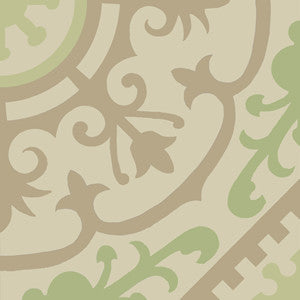
Cuban Heritage Pattern 140 Color Substitution No. 1 - Virtual Design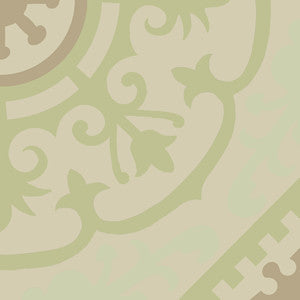
Cuban Heritage Pattern 140 Color Substitution No. 2 - Virtual Design -
Order strike off samples. Before we start making your tiles for the "full order", you'll need to order strike-off samples for design approval. Strike-off samples are samples of your custom design and give you the confidence you need to ensure the full-order can begin. Do the sample tiles look close to the virtual design?
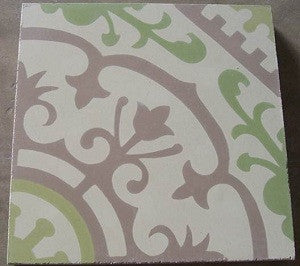
CH140 Substitution #1 Sample Photo of Cement Tile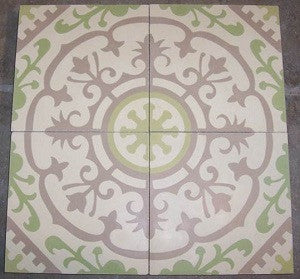
CH140 Substitution #1 Grouping Photo of Cement Tile Strike-Off Sample
CH140 Substitution #2 Photo of Cement Tile Strike-Off Samples
CH140 Substitution #2 Grouping Photo of Cement Tile Strike-Off Samples
- Approve the samples! Now your tile order can begin. Allow about eight weeks for your tiles to be manufactured and delivered.
While not all customers find it necessary to purchase strike-offs, it's highly recommended. While some geometric patterns in two or three colors might be easy to visualize, it's not always the case with traditional patterns, like this Cuban pattern when you are using five or six colors. The strike-off does ensure that you'll be pleased and confident when placing your finally order. Most strike offs take about three weeks and costs about $250 for four pieces, including shipping.
Like any creative process, you can see that customizing the colors of a cement tile pattern takes time and patience. In the end, you'll be rewarded with the satisfaction of tiles you designed!
